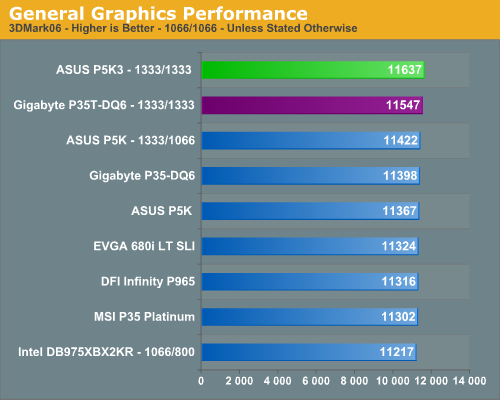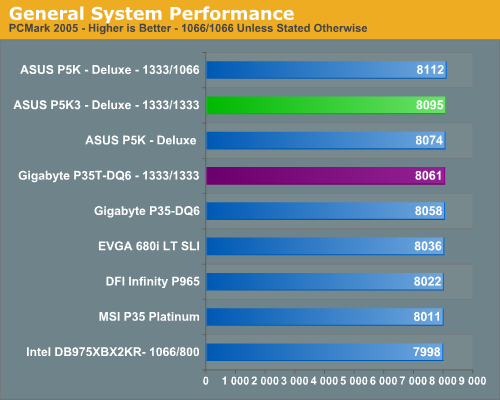Gigabyte GA-P35T-DQ6: DDR3 comes a knocking, again
by Gary Key on May 30, 2007 2:00 AM EST- Posted in
- Motherboards
Synthetic Graphics Performance
The 3DMark series of benchmarks developed and provided by Futuremark are among the most widely used tools for benchmark reporting and comparisons. Although the benchmarks are very useful for providing apples-to-apples comparisons across a broad array of GPU and CPU configurations they are not a substitute for actual application and gaming benchmarks. In this sense we consider the 3DMark benchmarks to be purely synthetic in nature but still very valuable for providing consistent measurements of performance.


In our 3DMark06 test, all of the boards are bunched together with a 3.7% spread from top to bottom. The 975X board takes last place by a small margin and we expect this to improve once we have new R600 drivers. The P5K3 board offered the best CPU and SM2.0 scores in this benchmark although the P35T-DQ6 offered the best SM3.0 scores. This is one of a few tests that show the ASUS DDR3 board to have slightly better performance than the Gigabyte DDR3 board when the benchmark is CPU limited.
In the more memory sensitive 3DMark01 benchmark we see our Gigabyte P35T-DQ6 board taking top honors with a very strong showing against the ASUS boards. Our 975X board is slightly handicapped at the 1066FSB/DDR2-800 settings although this chipset continues to offer excellent memory performance in this type of benchmark. The spread from top to bottom is only 2.6%, however, so minor differences in performance are not really noticeable in either 3DMark unless you count on the differences for individual benchmark scores.
General System Performance
The PCMark05 benchmark developed and provided by Futuremark was designed to evaluate overall system performance for the typical home computing user. This tool provides both system and component level benchmarking results utilizing subsets of real world applications or programs. This benchmark is useful for providing comparative results across a broad array of Graphics, CPU, Hard Disk, and Memory configurations along with multithreading results. In this sense we consider the PCMark benchmark to be both synthetic and real world in nature, and it again provides for consistency in our benchmark results.

The ASUS boards have always done well in this benchmark due to very strong multitasking performance and the same holds true once again in our test with the Gigabyte DDR3 board. The spread in overall scores is only 1.5%, although in individual areas the differences between the boards may be more or less pronounced.
The 3DMark series of benchmarks developed and provided by Futuremark are among the most widely used tools for benchmark reporting and comparisons. Although the benchmarks are very useful for providing apples-to-apples comparisons across a broad array of GPU and CPU configurations they are not a substitute for actual application and gaming benchmarks. In this sense we consider the 3DMark benchmarks to be purely synthetic in nature but still very valuable for providing consistent measurements of performance.


In our 3DMark06 test, all of the boards are bunched together with a 3.7% spread from top to bottom. The 975X board takes last place by a small margin and we expect this to improve once we have new R600 drivers. The P5K3 board offered the best CPU and SM2.0 scores in this benchmark although the P35T-DQ6 offered the best SM3.0 scores. This is one of a few tests that show the ASUS DDR3 board to have slightly better performance than the Gigabyte DDR3 board when the benchmark is CPU limited.
In the more memory sensitive 3DMark01 benchmark we see our Gigabyte P35T-DQ6 board taking top honors with a very strong showing against the ASUS boards. Our 975X board is slightly handicapped at the 1066FSB/DDR2-800 settings although this chipset continues to offer excellent memory performance in this type of benchmark. The spread from top to bottom is only 2.6%, however, so minor differences in performance are not really noticeable in either 3DMark unless you count on the differences for individual benchmark scores.
General System Performance
The PCMark05 benchmark developed and provided by Futuremark was designed to evaluate overall system performance for the typical home computing user. This tool provides both system and component level benchmarking results utilizing subsets of real world applications or programs. This benchmark is useful for providing comparative results across a broad array of Graphics, CPU, Hard Disk, and Memory configurations along with multithreading results. In this sense we consider the PCMark benchmark to be both synthetic and real world in nature, and it again provides for consistency in our benchmark results.

The ASUS boards have always done well in this benchmark due to very strong multitasking performance and the same holds true once again in our test with the Gigabyte DDR3 board. The spread in overall scores is only 1.5%, although in individual areas the differences between the boards may be more or less pronounced.










22 Comments
View All Comments
Chunga29 - Wednesday, May 30, 2007 - link
[With apologies to Monty Python, I present the Quest for the Holy Chipset....]------------------
"One day, lad, all this will be yours!"
"What, the heatsinks?"
"No. Not the heatsink, lad. All that you can see, stretched out over the caps and resistors of this land! This'll be your motherboard, lad."
"B-- b-- but Father, I don't want any of that."
"Listen 'Erbert. We live in a bloody planet full of global warming. We need all the heatsinks we can get."
"But-- but I don't like her."
"Don't like her?! What's wrong with her?! She's beautiful. She's rich. She's got huge... tracts o' land!"
Spoelie - Wednesday, May 30, 2007 - link
wtf is wrong with intel boards lately??I mean, in every article I read, it doesn't matter how HUGE the heatsink is, "additional airflow was required to ensure stability". Or do you mean just a casefan?
I still have a dfi nforce4 ultra board, replaced the (tiny!) chipset cooler with a thermaltake hr something, and the chipset temp dropped 10°C, htt goes wel over 300. Huge difference there.